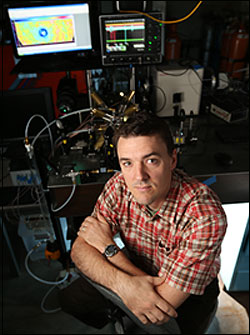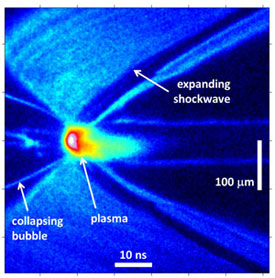A Vanderbilt engineering graduate student has created a small-scale, efficient way to produce high energy density plasma using a tabletop device. Its features and capabilities are described in an article published in the April edition of Physical Review Letters.

Marc Ramsey, a doctoral candidate in mechanical engineering, presented the work last year at the IEEE International Conference on Plasma Science in Edinburgh, where he received an honorable mention for best student paper.
Ramsey has demonstrated how the tabletop device generates plasma at more than one million atmospheres at the center of a collapsing bubble, creating conditions with relevance to basic physics and astrophysics that are very difficult and expensive to create by other means.
By collapsing an ordinary vapor bubble in water, the device focuses energy and takes advantage of what’s called inertial confinement to generate incredible pressure for a very short period of time – less than five nanoseconds – before flying apart again. Plasmas at the conditions created in the experiment exist at the centers of giant planets like Jupiter and occur during some astrophysical events, Ramsey explained. At those kinds of pressures, there are no solids or liquids – only plasma.
Usually such conditions are recreated at massive national facilities, such as the “Z” machine at Sandia Labs. There are only a few such facilities in the world.
“The efficiencies of those facilities are very low,” said Ramsey. “It takes an incredible amount of energy to do a very small thing. You can generally do only one experiment a day.”

While the device demonstrated at Vanderbilt cannot recreate every experiment conducted at the large facilities, it sits on a table-top and can fire several times per minute. The power supply is the size of a shoe box.
Ramsey hopes his device will contribute to basic science by increasing understanding about the physics of plasmas and matter at extreme pressure temperature, and density.
“The types of conditions this can produce are a small subset of what those other facilities can produce. But this at least gets into the ballpark for thousands or millions of times less money, time and energy,” he said. “It will allow us to study the properties of these types of plasmas at a very small scale and mathematically scale it up to the larger events.”

The device works by pumping water to a vacuum, then nucleating a bubble with a spark from a low energy laser pulse, Ramsey explained. Raising the pressure quickly then causes the bubble to collapse and carry energy into a very small volume, creating a pinpoint of light. Generating a similar event in the large facilities requires thousands or even millions of joules of energy, and makes a big mess that has to be cleaned up. This device requires only one joule, Ramsey said, and can be repeated several times per minute. Joules are how scientists measure energy.
Ramsey received his undergraduate degree at Clemson and later joined Sandia National Labs, where he developed an interest in high-energy density plasma. “I realized I was more interested in the experiments than the mechanical design, and that’s what led me to come back to graduate school,” he said.
Ramsey was attracted to Vanderbilt by Robert Pitz’s research in combustion. Pitz, chair of the mechanical engineering department, became Ramsey’s doctoral adviser, providing vital lab space, equipment, support and encouragement. After a year working in Pitz’s lab, Ramsey attended a high energy density physics conference in Los Angeles. He listened to presentations on plasma work conducted on the more massive scale.
“During a break, I was wandering the hallways at UCLA, and on a professor’s door I saw an article about sonoluminescence, which has to do with tiny collapsing bubbles, so I just put those two things together,” he said.
Over the next year he continued thinking about the problem of how to create a small-scale plasma experiment with bubbles dramatically larger than those in sonoluminescence. He realized Pitz’s lab had all the equipment he needed to pursue his idea. A $50,000 discovery grant from Vanderbilt got the process started. Additional funding from Sandia Labs and a National Science Foundation Graduate Fellowship helped further the research.
Recognition for the paper at the conference last summer helped Ramsey verify he was on to something. “No one else at Vanderbilt does high energy density physics, so you’re not sure until you’re able to present to your peers who see the value. Now I see I’m on solid ground. Being at Vanderbilt gave me the time, confidence and freedom to develop a new idea and get it going.”
Ramsey said he now sees himself devoting his entire career to working on devices that will recreate this kind of event. “It’s rich enough and there’s enough I still don’t understand that I expect it to be a lifelong pursuit.”